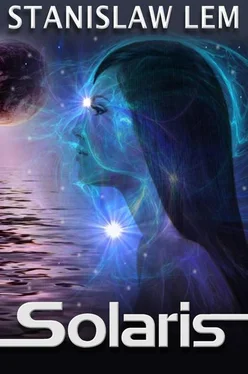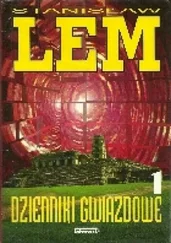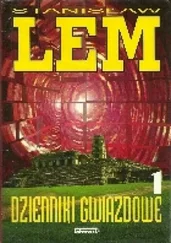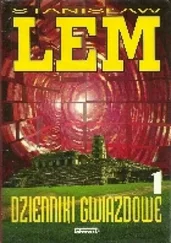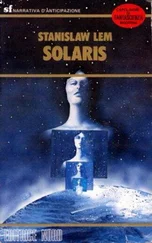But, incapable of admitting that this is truly the case, solaricists scrupulously avoid all commentary on Contact, such that in their writings it becomes something ultimate — and while in its initial, still sober sense it was supposed to be a beginning, an introduction, an entry point onto a new path, one of many, it became beatified, and after the passage of years it turned into their eternity and their heaven…
Straightforward and bitter is the analysis offered by Muntius, that “heretic” of planetology; dazzling in its negation, in shattering the myth of Solaris, or rather of the Human Mission. That first voice, which dared to speak out as solaristics was still a developing field imbued with confidence and romanticism, was greeted with complete disregard and silence — something only too understandable, since accepting Muntius’s words would have been tantamount to erasing solaristics completely as it had existed thus far. The beginnings of a different, dispassionate, modest solaristics waited in vain for a founder. Five years after Muntius died, by which time his book had become a bibliographic rarity, a collector’s item not be found either in any solaristic series or in philosophy libraries, a school named after him arose — a Norwegian circle in which the composure of his exposition, divided among the different characters of the thinkers assuming his legacy, turned into the caustic, pigheaded sarcasm of Erle Ennesson, and in a somewhat trivialized version, the “utilitarian” solaristics of Phaelanga; the latter called for a focus on the concrete benefits to be gained from research, without becoming distracted by the daydreams and false hopes of civilizational contact and intellectual communion between two civilizations. Yet next to Muntius’s pitiless analysis, the writings of all his intellectual disciples are little more than footnotery, if not garden variety popularization, with the exception of the works of Ennesson and possibly Takata. Muntius himself had essentially accomplished everything, labeling the first phase of solaristics the “period of the prophets,” among whom he included Giese, Holden, and Sevada; the second phase he called “the great schism”—the splitting of the one solarian Church into a clutch of warring denominations; and he predicted a third phase — one of dogmatism and scholastic fossilization which would set in when everything there was to research had already been researched. This, however, did not happen. I believe Gibarian was correct after all in seeing Muntius’s scorched-earth exposition as a massive over-simplification that disregarded anything in solaristics that ran contrary to the elements of faith; for in reality what predominated in the field was unceasingly mundane research that promised nothing beyond a material globe orbiting around two suns.
Inside Muntius’s book there was a faded offprint from the journal Parerga Solariana , folded in two. It was one of the first papers Gibarian had written, before he became director of the Institute. After the title—“Why I Am a Solaricist”—there followed a list, concise as a precis almost, of the specific phenomena that justified the real possibility of Contact. For Gibarian belonged to what may well have been the last generation of researchers who had the courage to refer back to the glory days of optimism and were not averse to their own kind of faith, which went beyond the boundaries laid down by science, yet was eminently material, since it believed their efforts would succeed so long as those efforts were sufficiently persistent and unceasing.
He was trained in the well-known, classic bioelectronic line of research of the Eurasian school, which included Cho-En-Min, Ngyalla, and Kavakadze. This work had demonstrated similarities between images of the electrical functioning of the brain and certain discharges that occurred within the plasma preceding the appearance of some of its formations, including early-stage Polymorpha and geminate Solarids. He rejected overly anthropomorphic interpretations, all those mystical notions of the psychoanalytic, psychiatric, and neurophysiological schools, which sought to attribute to the neurogliac ocean particular human ailments such as epilepsy (the analogue of which were supposedly the convulsive eruptions of asymmetriads), because among the advocates of Contact he was one of the most cautious and clear-headed, and could not abide anything so much as the sensationalism which, admittedly very infrequently, accompanied one or another discovery. As it happened, a wave of exactly this kind of cheap interest was provoked by my doctoral dissertation. That was here too, though of course not in printed form — it was buried in one of the microfilm capsules. In it, taking as my starting point the innovative research of Bergmann and Reynolds, who from the mosaic of cortical processes had succeeded in identifying and “filtering out” the components accompanying the most powerful emotions — despair, pain, joy — I went on to juxtapose those recordings with discharges emitted by currents in the ocean, and discovered oscillations and patterns in the curves (in certain parts of the symmetriads’ canopy, at the base of immature mimoids, and elsewhere) that offered a noteworthy analogy. This was enough for my name to appear soon afterwards in the gutter press beneath ludicrous headlines along the lines of “Despair of the Jelly” or “Planetary Orgasm.” But this worked out to my advantage (or so I thought till recently), since I came to the attention of Gibarian who, like any other solaricist, did not read every one of the thousands of papers being published, especially those written by novices. He wrote me a letter. That letter closed one chapter of my life, and opened up a new one.
After six days, the lack of any reaction whatsoever inclined us to repeat the experiment, at which the Station, which thus far had stayed in place at the intersection of the forty-third parallel and the one hundred and sixteenth meridian, moved off at an altitude of twelve hundred feet above the ocean towards the south, where, as the radar sensors and radiograms from the Satelloid were indicating, there had been significantly increased activity in the plasma.
For two days the bundle of X-rays modulated by my encephalogram pounded the almost completely smooth surface of the ocean at intervals of several hours.
Towards the end of the second day we found ourselves so close to the pole that when the disk of the blue sun had almost completely disappeared beyond the horizon, the crimson tinge of the clouds in the opposite direction heralded the rising of the red sun. The vast blackness of the ocean and the empty sky above it were then filled with a blindingly fierce clash between hard colors aglow like metal, glistening with poisonous green and subdued hollow flames of crimson, while the ocean itself was rent with the glare of two counterposed disks, two furious fires, one mercuric and one scarlet; at such moments it was enough for the tiniest cloud to be at the zenith for the rays falling across the diagonals of waves with their lumbering foam to be lit up with an incredible rainbow glitter. Immediately following the setting of the blue sun, on the north-west skyline, first heralded by the indicators, there appeared a symmetriad; it was fused almost indistinguishably with the red-stained mist and arose out of it only with isolated glinting reflections, like an immense glass flower growing from the meeting point of sky and plasma. The Station, however, maintained its course, and fifteen minutes or so later the colossus, red and trembling like a guttering lamp made of rubies, vanished again beyond the horizon. A few minutes later a tall thin pillar, whose base was hidden from our view by the curvature of the planet, shot up soundlessly several miles into the atmosphere. This clear indication of the end of the symmetriad we’d seen, one side fiery red, the other bright as a column of quicksilver, branched into a two-colored tree, then the extremities of its ever more spreading limbs merged into a single mushroom-shaped cloud whose upper portion set off in the fire of two suns on a distant journey driven by the wind, while the lower part fell extraordinarily slowly in ponderous clusterlike fragments spread across a good third of the horizon. An hour later the last trace of this spectacle had vanished.
Читать дальше
